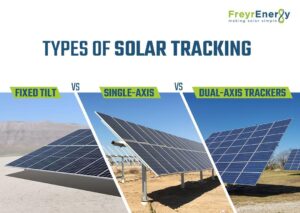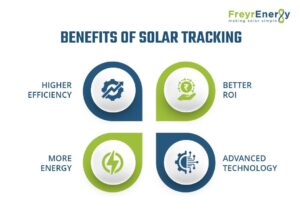With the rising demand for renewable sources, solar panels are being increasingly deployed in many homes and industries. For solar panels to perform optimally, they have to receive sunlight continuously, which is not possible due to the movement of the sun.
This is when the role of solar tracking comes. In this blog, we have guided you through solar tracking and its importance in improving solar panel efficiency.
What is solar tracking?
Solar tracking is the use of a mechanical device to position solar panels so that they capture abundant sunlight, enabling maximum energy generation throughout the day. Solar panels remain perpendicular to the sun’s rays to receive sunlight continuously.
Why solar tracking matters?
With solar tracking devices, the orientation of the panels is adjusted constantly, ensuring they always face the sun. In a country like India, where sunlight is abundantly available, it is essential to capitalize on it and reduce dependence on non-renewable sources of energy.
A significant increase in energy generation can be witnessed when solar tracking systems are installed. Even households in high-altitude areas can install solar panels as energy production becomes possible with a solar tracking system.
Solar tracking, thus, is imperative to make the most of the available sunlight to generate electricity without any hindrance.
Types of solar trackers

Single-axis solar trackers
Single-axis trackers guide the movement of solar panels along only one axis, namely the sun’s movement from east to west. Despite following a single path, they are highly cost-effective and increase energy production levels.
A single-axis solar tracking system may have different configurations, such as:
- Vertical, where panels move around a vertical axis
- Horizontal, where panels move along a horizontal axis
- Inclined, where the movement is around an inclined axis
Of the above three, horizontal trackers are more commonly used due to their suitability in low-altitude regions that receive a good amount of sunlight throughout the year.
Single-axis trackers require low maintenance and are durable. They are highly suitable for large-scale installations that may be required in commercial establishments.
Dual-axis trackers
These advanced tracking systems move the solar panels along two axes, namely, east-west and north-south. They cover the sun’s daily movement as well as the seasonal changes. Due to this reason, they ensure that the panels are optimally placed, thus enabling maximum energy production throughout the year.
Dual-axis systems are sophisticated than the single-axis trackers and hence require more maintenance. They are highly suitable for high-altitude regions and other areas where the sun’s angle varies considerably.
They are suitable for installation in large-scale solar projects involving huge costs, as the installation process is quite complex.
Active tracking systems
These are powered by electricity from the solar system and use sophisticated sensors and motors. Active trackers are highly efficient as they continuously track the sun’s movement with their powerful sensors.
Passive tracking systems
Suitable for simple solar panel installations, they use thermal expansion of gases to move the solar panels and return them to their vertical axis at night. They are not accurate, hence not suitable for concentrated PV systems.
Benefits of solar tracking

Augments energy production
Solar tracking enables maximum sun absorption by panels, which leads to increased energy production without any interruption.
Efficient land usage
Highly suited for areas with limited land availability since solar trackers produce more energy in the same panels, by just positioning the panels according to the movement of the sun.
Longevity of solar panels
A solar panel tracking system extends the life of solar panels as they are more efficient without any stress.
Financial return
Solar tracking systems enable higher outputs in shorter periods. This gives a quick return on investment, without any waiting period.
More efficiency
Peak-hour sunlight utilization is best with solar tracking systems. This results in efficient functioning of panels without any energy loss.
Solar tracking and panel efficiency
Fixed solar PV panels fail to capture sunlight when the sun is out of range of the optimal angle. However, solar trackers help panels orient towards the sun, thereby increasing output by 10-25%. Since solar tracking systems capture sunlight throughout the day and in all seasons, the efficiency of solar panels increases manifold.
Solar energy tracking systems follow advanced technology where sensors detect the optimal position of the panels by tracking the movement of the sun. This way, they ensure that the panels are perpendicular to the sun’s light.
While a single-axis solar tracking device can result in an energy increase of 25-30%, dual-axis devices can bring about 40-60%.
Large-scale solar installations can experience panel efficiency for a long time with solar energy trackers.
Challenges and limitations
- The cost of installation of solar tracking systems increases the initial investment in solar systems.
- The process of installation is complicated, necessitating specialized expertise.
- Solar power tracking requires a lot of maintenance. Also, dual-axis systems are complex, and a lack of maintenance can impair their functioning.
- Solar tracking systems are not suitable for small households as they cannot bear the high upfront cost.
- Solar trackers are prone to damage due to extreme weather conditions.
Conclusion
Solar tracking is important for maintaining the position of the panels to receive optimal sunlight. In spite of its uses and importance, solar tracking devices cannot fit into the budget of small homeowners.
However, larger establishments can leverage the use of solar trackers and enjoy a greater return on investment. It will also help in the larger goal of achieving a pollution-free nation.
